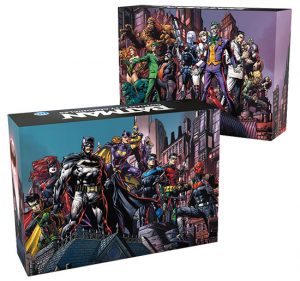 Who is the most iconic hero in all of comicdom? Clearly, it’s Batman (don’t @ me). The caped crusader has been thwarting villains’ dastardly schemes since 1939 and has long been a staple of my comic book reading. Yet despite Batman conquering comics, movies, and video games, he has yet to make his mark (positively at least) on our tabletops. But could the wait finally be over?
Who is the most iconic hero in all of comicdom? Clearly, it’s Batman (don’t @ me). The caped crusader has been thwarting villains’ dastardly schemes since 1939 and has long been a staple of my comic book reading. Yet despite Batman conquering comics, movies, and video games, he has yet to make his mark (positively at least) on our tabletops. But could the wait finally be over?
In a quest to fix that omission, publisher Monolith has released Batman: Gotham City Chronicles (Batman: GCC), an Asymmetric game for 2-4 players that takes about 60-90 minutes to play. Batman: GCC plays best with 2 players.
Gameplay Overview:
This will be a high-level overview of how to play Batman: GCC. If you want a full tutorial, check out this video series.
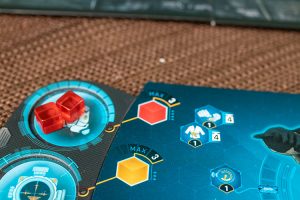
Batman: GCC is a scenario-based game where one player controls the villains of Gotham City, while the rest take on a familiar batverse hero (depending on the options the scenario gives you). Most scenarios will have a goal that the heroes need to accomplish to win (disarm bombs, save hostages, gather evidence, etc…).
When the heroes are up, they take their turn in any order they choose. The heart of a hero’s activation is through the energy cube system. Pretty much everything a hero wants to do costs an energy cube. Want to punch a thug? Disarm a bomb? Defend from a shotgun blast? Move a few extra areas? Each cube you spend lets you roll one die or move one area. Dice come in a variety of levels and your hero board will tell you which dice you roll. Energy cubes are replenished at the start of your turn depending on if you are resting or active. Resting gives you many more cubes back, but you can basically do nothing for the turn.
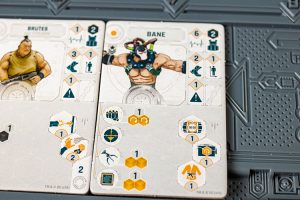
When it’s the villain players turn, they can choose up to two tiles to activate on their “river”, the line of tiles of villains and minions. The cost to activate a tile is above it, and the cost increases as you go down the river. After activating a tile, the player can move and perform an action with all miniatures of that group (attack, hack a computer, arm a bomb, etc.). Instead of using cubes to decide the power of the action, the villain’s stats are set. After activating a tile, it gets move to the end of the line (in the highest cost slot), and everything else slides down to fill the gaps. So, while you can activate Joker twice in a turn, it will usually be prohibitively expensive.
Each hero and villain also have a number of special abilities and weapons/gadgets. The game uses heavy iconography for the abilities, but overall the diverse set of abilities help to make each character feel unique.
Missions end usually when the timer runs out (typically 7 rounds or so). If the heroes accomplished their goals, they win. If not, the villain is triumphant.
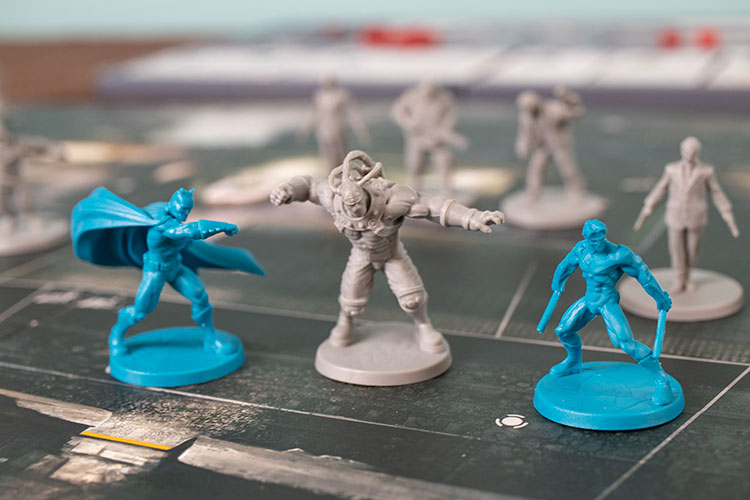
Game Experience:
One thing I can immediately say about Batman: GCC is that once you get your head around the rules, they system flows really well. As long as you have your ability icons down, then spending energy cubes and performing actions is really intuitive. Hero boards are broken up into different areas, so it’s clear where to spend the cubes if you want to move or attack.
While the core game only comes with 4 maps, the almost 2 dozen scenarios make good use of them. There are some nice variety in the missions, both in terms of goals and also the characters players use. Each mission clearly lists out which characters player can choose (with the heroes usually getting to pick from a few options). This also helps give the scenarios more “legs” as switching up the heroes you choose in a scenario can give it a different feel and change the approach you need to take.
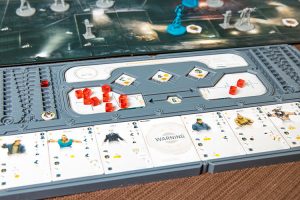
While I haven’t played every scenario, from our playtest games, it does feel like the Villains have a slight advantage in the game. The margin for error of the heroes feels fairly slim, and a few unlucky dice rolls can be the difference from winning and defeat. Playing the villain felt a LOT more forgiving than the heroes. This isn’t a game where Batman can just fly in and punch people. You only have a limited amount of time to accomplish your goals and you must be careful of how you spend your energy.
And that’s really the heart of the game, the energy management system. You can do almost anything in Batman: GCC, as long as you spend the energy to do it. This is a game full of choices and options. Want to move just an extra few spaces? Spend those cubes. Want to take out Bane in only 1 turn. You can save up your cubes and unleash it all in one massive attack. However, it will also leave you winded and needing to rest next turn. There are decisions to make at every turn and in no point does the game feel “on rails”.
My main criticism of Batman: GCC will land squarely on the rulebook. Frankly, it’s straight up awful to learn the game from. I’m skeptical that Monolith ever handed this book to someone that hadn’t played the game before and got a “thumbs up, all good” from them. It reads like a set of stereo instructions from 1984. That being said, it works decently well as a rules reference. But to learn to play? I’d suggest skipping it and watching one of the online videos.
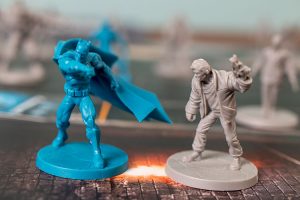
Another notable omission was the lack of player aids of any kind. With so many symbols to remember, that was a crucial oversight. Thankfully, Monolith has already released a PDF you can download and print out. Still, it strikes me as strange that this wasn’t included in the core game.
But once you gronk the rules and the symbols, Batman: GCC is a highly thematic game that not only looks great but is a ton of fun to play. Batman just feels impressive with his high attack dice and other abilities. This is a game that after almost every play, I want to immediately play another round of it. In fact, the since the scenario setup is somewhat lengthy, one of the best things to do is to swap sides after one play. That way you don’t have to setup the game again or learn any new scenario rules. And the asymmetrical gameplay really does feel different playing the villain vs the heroes.
Which is another reason I think this game plays best with 2 players. While it’s certainly fine with 3-4 players, I’ve found that controlling a couple of heroes is not much of a struggle. And it also allows you to rest a hero on your turn and not feel like you are doing nothing. I can rest Batman this turn and still have a great, active turn with Nightwing. Had I only been controlling one hero; I’d be forced to basically just skip a turn and do nothing.
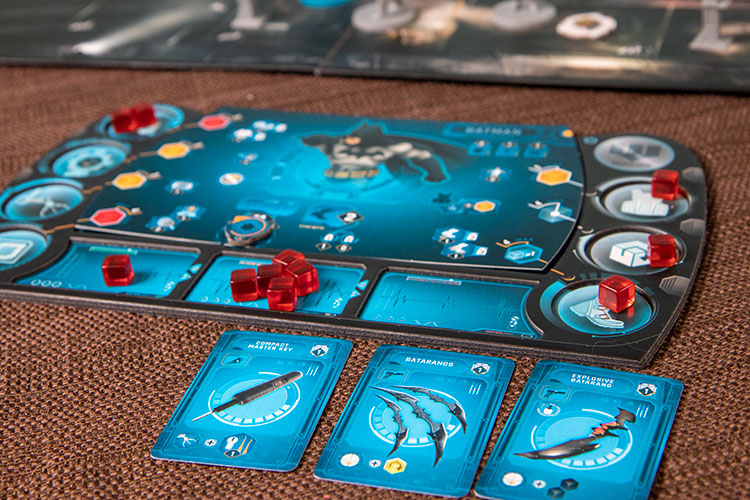
Final Thoughts:
Despite its hefty price tag, Batman: Gotham City Chronicles is every bit the thematic Batman experience it promises. The miniatures look great, the gameplay is very smooth (once you get the rules and icons down), and the scenarios offer a lot of replay value.
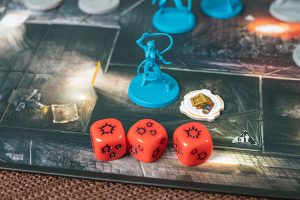
While the game clearly needs an updated rulebook and should have include player aids, neither of those stopped us from enjoying our time in Gotham City. Is it perfect? Of course not, but I enjoyed the objective based gameplay over just another “beat em up” skirmish game. I’m always a little wary about licensed board games as the IP can sometimes be used as a crutch, rather than a theme to base a game around. Thankfully, Monolith didn’t fall into the trap.
Finally, as a side note, I find myself eager to try out the VS mode expansion for Batman: Gotham City Chronicles. I’m curious of that’s a better way to play as it lowers some of the mission requirements and might put things on more even footing for the heroes and villains.
Final Score: 4.5 Stars – An excellently crafted game that does a great job bringing Batman to our tabletops. While not without its production issues, the smooth gameplay and thematic elements makes this one I’ll be pulling out quite often.
 Hits:
Hits:
• Thematic Missions
• Tons of replay value
• Smooth, tactical gameplay
• A dice chucker with a bit of a eurogame heart
Misses:
• Rulebook needs a lot of help
• No player aids
• Heroes have less margin for error than the villains























Did you had the chance to play the VS mode yet?
I have and I enjoyed it. Although I found myself just going back to the adventure mode. VS. Mode is good if you want to customize your team. There is one VS. mission that completely removes the objectives and, instead, you just want to kill all the other team’s people. But I found that to be one of the least interesting missions and realized I really liked the objective based gameplay.
Did you play with any expansions or just the base game?
My review was just for the base game. I’ve since gotten some of the expansions as well.